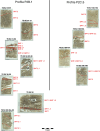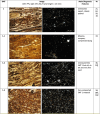Understanding late medieval farming practices: an interdisciplinary study on byre remains from the historical centre of Brussels (Belgium)
- PMID: 40585909
- PMCID: PMC12198283
- DOI: 10.1007/s12520-025-02248-w
Understanding late medieval farming practices: an interdisciplinary study on byre remains from the historical centre of Brussels (Belgium)
Abstract
During the preventive archaeological excavation in the cellar of the site of petite Rue des Bouchers in the historical centre of Brussels (Belgium), the waterlogged remains of a thirteenth century AD sunken byre (potstal) were discovered. The exceptional preservation instigated a multiproxy approach, including micro-archaeology, micromorphology, phytolith and endoparasite egg analysis on thin sections, palynology and the study of plant macroremains on the fill of the structure. Beyond permitting to detail the content and the multiple origins of the fill (including excremental waste and urines, fodder and bedding material, plaggen and/or soil sods, household and construction waste), this study also provides detailed insights into the foddering customs, hygienic conditions within the stable, and the health status of the animals kept. On a more general scale this study documented late medieval farming practices in Brussels, more specifically the need to collect substantial amounts of manure to add as fertilizer onto the cultivated poor sandy soils.
Supplementary information: The online version contains supplementary material available at 10.1007/s12520-025-02248-w.
Keywords: Archaeobotany; Manure; Medieval; Micromorphology; Palaeoparasitology; Stable.
© The Author(s) 2025.
Conflict of interest statement
Competing interestsThe authors declare no competing interests.
Figures












Similar articles
-
The effectiveness and cost-effectiveness of carmustine implants and temozolomide for the treatment of newly diagnosed high-grade glioma: a systematic review and economic evaluation.Health Technol Assess. 2007 Nov;11(45):iii-iv, ix-221. doi: 10.3310/hta11450. Health Technol Assess. 2007. PMID: 17999840
-
Roman surgery in Armorica.Int Orthop. 2025 Jul;49(7):1747-1752. doi: 10.1007/s00264-025-06550-z. Epub 2025 May 7. Int Orthop. 2025. PMID: 40332583
-
Interventions targeted at women to encourage the uptake of cervical screening.Cochrane Database Syst Rev. 2021 Sep 6;9(9):CD002834. doi: 10.1002/14651858.CD002834.pub3. Cochrane Database Syst Rev. 2021. PMID: 34694000 Free PMC article.
-
Smoking cessation medicines and e-cigarettes: a systematic review, network meta-analysis and cost-effectiveness analysis.Health Technol Assess. 2021 Oct;25(59):1-224. doi: 10.3310/hta25590. Health Technol Assess. 2021. PMID: 34668482
-
Factors that influence parents' and informal caregivers' views and practices regarding routine childhood vaccination: a qualitative evidence synthesis.Cochrane Database Syst Rev. 2021 Oct 27;10(10):CD013265. doi: 10.1002/14651858.CD013265.pub2. Cochrane Database Syst Rev. 2021. PMID: 34706066 Free PMC article.
References
-
- Albert RM, Shahack-Gross R, Cabanes D, Gilboa A, Lev-Yadun S, Portillo M, Sharon I, Boaretto E, Weiner S (2008) Phytolith-rich layers from the Late Bronze and Iron Ages at Tel Dor (Israel): mode of formation and archaeological significance. J Archaeol Sci 35:57–75. 10.1016/j.jas.2007.02.015
-
- Alonso-Eguiluz M, Albert RM, Verges M, Fernandez-Eraso J (2024) New insights into shepherds’ activities: Multi-proxy approach applied to fumier deposits from the north of Iberian Peninsula. Quatern Int 683–684:145–161. 10.1016/j.quaint.2023.06.012
-
- Alonso-Eguiluz M, Lo Russo S, Vrydaghs L, Tribel P, Bontempi G, Schenkel A, Celis D, Nys K, Devos Y (2025) Two methods, two views: Integrating phytoliths in thin sections and bulk samples on the urban Dark Earths from the DIVA-site (Antwerp, Belgium). PLoS ONE 20:e0320122. 10.1371/journal.pone.0320122 - PMC - PubMed
-
- Antolín F, Steiner B, Vach W, Jacomet S (2015) What is a litre of sediment? Testing volume measurement techniques for wet sediment and their implications in archaeobotanical analyses at the Late Neolithic lake-dwelling site of Parkhaus Opéra (Zürich, Switzerland). J Archaeol Sci 61:36–44. 10.1016/j.jas.2015.04.019
-
- Arpin TL, Mallol C, Goldberg P (2002) A New Method of Analyzing and Documenting Micromorphological Thin Sections Using Flatbed Scanners: Applications in Geoarchaeological Studies. Geoarchaeology 17(3):305–313. 10.1002/gea.10014
LinkOut - more resources
Full Text Sources
